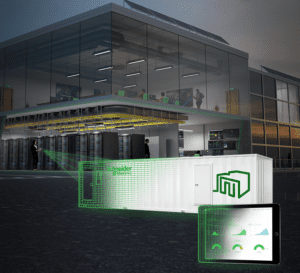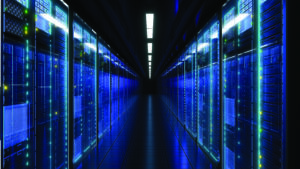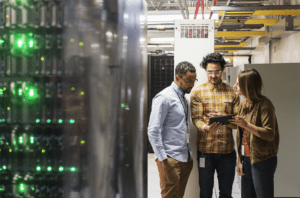Q&A with Schneider Electric’s New Head of Engineering & Technology for Modular Data Center Solutions
INTRO: We caught up with Tuan Hoang, newly appointed head of engineering and technology for Schneider Electric’s Modular Data Center solutions, to get his perspective on the latest trends in prefabricated modular data centers and sustainability.
Q. JOE KRAMER: Welcome Tuan. Tell us a little bit about your background.
A. TUAN HOANG: My background is in aerospace engineering, mechanical engineering and manufacturing. Before I joined Schneider Electric, I worked for Northrop Grumman on their nuclear aircraft carrier program. Then I spent eight years at Lee Technologies, an engineering firm focused on data centers. At Lee Technologies, I was involved with all facets of a turnkey data center solution including engineering, project management and pre-construction. One of the trends we observed was the increase in demand for fully prefabricated modular data centers, as well as the increased inclusion of prefab components in stick-built data center projects. Schneider Electric acquired my firm for a variety of reasons and a primary one was our extensive experience with design-build construction, which we use to help build reliable data centers fast and more cost effectively.
Q. JK: Data centers come in many form factors, transforming from stick built to modular. What are the considerations for both you and customers?
A. TH: With modular data centers, customers are generally looking to solve one of three often competing objectives. They want increased flexibility, faster speed to market and improved predictability. But, those three things don’t always converge into the perfect solution. Obviously, speed costs money and flexibility can be a direct challenge to predictability and cost. We often play the role of consultant – by understanding how the customer plans on using their solution, we can help balance their business needs with technology that will help achieve their goals. The modular approach is a methodology, it’s not really a product, it’s how we solve your business needs.

Q. JK: Does modular design offer any advantage to being sustainable versus designing as part of the building infrastructure?
A. TH: Yes, stick building requires a lot of earth moving and a lot of concrete. You’d be amazed at the environmental impact of concrete. It’s not just energy, it’s water usage as well. With modular, if we are providing the data center on steel and shipping it to the site, then it doesn’t have to be on a concrete pad. It doesn’t have to be in a concrete building and it’s self-sustaining. In addition, steel is much more recyclable than concrete.
Q. JK: Data centers can consume a tremendous number of resources, especially at scale. You’ve worked with a lot of the internet giants, the hyperscale cloud and service providers and colocation companies. How are they approaching sustainability initiatives?
A. TH: The C-Suite in nearly all the Fortune 500 companies and even those below that level are serious about setting and attaining sustainability goals. It may not have filtered completely down to the facilities or operations yet, but in the C-suite, the messaging is there, the commitment is there. Companies are challenging themselves to improve environmental performance goals, and by doing this they are also putting out a call-to-action for industry partners to do the same.
Q. JK: Sustainability is more than just cutting emissions or reducing energy costs, correct?
A. TH: That’s correct. It’s not just about energy consumption. Most people focus on that because it’s the most obvious, most expensive and it’s the most potentially damaging to the environment. Yet, avoiding the use of certain technologies, materials or equipment can also help companies reach their sustainability goals. Reducing is great, but avoidance is better.
Q. JK: Are there specific examples?
A. TH: There are loads of examples, and many of them are commonsense. If, for example, you can source your materials within a 500-mile radius of your facility, you reduce the carbon footprint of your supply chain. A lot of the hyperscalers have already gone there. Also, they’re adopting adiabatic free cooling, so, they’re not using any refrigerant, there are no chillers, no compressors, no pumps. That exists today. Another example is that we can preassemble or prepackage components, so you shift the work from the field to a factory.
Also, software plays a key role in sustainability by enabling remote monitoring and management of data centers. This reduces the need for physical site visits by IT personnel and increases the overall efficiency of the operation through features like preventive and predictive maintenance.
In addition, the modular data center model allows companies to right-size their data center resources in a phased approach. Rather than building a large facility designed to accommodate future growth and only using a small portion of that building when it first comes online, a modular approach allows companies to deploy resources as needed and to scale as demand grows. Another benefit of this approach is that it enables companies to take advantage of new components or design architectures that might not have been available when the stick-built facility was constructed.
Q. JK: How does the modular process reduce waste and improve efficiency?
A. TH: By having all of the materials on site and using templates to build the modules, particularly for multi-phase deployments, we know exactly how much of each type of material we need. There’s little-to-no waste. Also, we are able to build up institutional knowledge for the installers because we have the same crews doing the same type of work over and over again. A modular data center is pre-assembled and tested in a controlled factory environment, achieving site-readiness without the need for additional construction and personnel results in improved efficiency.
Q. JK: Sustainability goals don’t always trickle down from the C-suite, so when you’re dealing with the purchasing person they might be focused on initial cost. How do you explain the total cost of ownership to customers?
A. TH: We try to emphasize to customers that a major component of sustainability is the end of life. Initial cost and operational costs are important, but what happens when you do a refresh? What do you do with that equipment? How much of it can be reused? Schneider has worked very hard on delivering end-of-life solutions that help companies address sustainability.
Q. JK: Have any of the hyperscalers discussed microgrids and incorporating renewable energy into their critical infrastructure?
A. TH: Yes, they’re interested in taking advantage of wind power, solar and onsite microgrids. There have also been requirements for the UPS to be grid interactive. We help customers look at it from end-to-end and incorporate renewable energy in their plans.
Conclusion
Hoang sums it up this way: The web giants are bringing companies like Schneider into their planning and brainstorming very early in the process. Schneider Electric can help them through the design, build, operational and end-of-life phases of the data center lifecycle. Tackling sustainability through the entire lifecycle means making a huge leap forward in addressing environmental impacts. Learn more about prefab modular data center solutions and how to reduce your organization’s data center carbon footprint.



